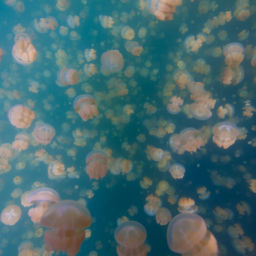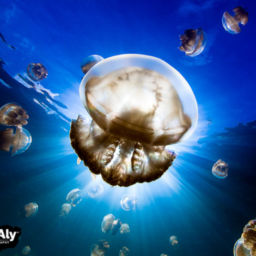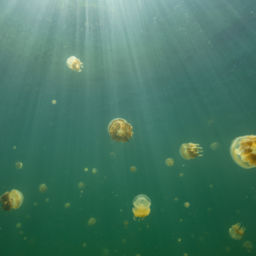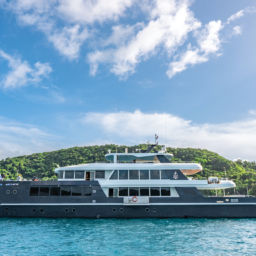You may have heard that the jellyfish in Jellyfish Lake in Palau were stingless. Or that the lake, once filled with millions of golden jellies, is now completely empty. Surprisingly, neither is entirely true. Here’s the real deal, directly from a discussion with the scientist-run Coral Reef Research Foundation of Palau. The organization has been closely monitoring Jellyfish Lake for years.
What is Jellyfish Lake?
The golden jellyfish (Mastigias papua etpisoni) in Jellyfish Lake are a unique subspecies. We find them only on one of Palau’s Rock Islands, in this specific lake — and nowhere else in the world. Surrounded by land with numerous indirect connections to the Pacific Ocean, and having an associated tidal rise and fall, this isolated lake contains layers that do not mix. The lake is just 1,312 feet (400 m) long and 98 feet (30 m) deep. The bottom layer receives no light and is hypoxic, containing no oxygen. Instead, poisonous hydrogen sulfide gas fills this layer. The pink middle layer, between 43 and 49 feet (13 to 15 m) is comprised of bacteria. Above that, the golden jellyfish swim.

The jellyfish lifecycle and migratory pattern
The golden jellyfish have two alternating life stages: the polyp and the medusa. The tiny, 2-mm polyps live at less than 33 feet (10 m) deep along the sides of the lake. The medusa is the mature version of the golden jellyfish, and each contains symbiotic algae called zooxanthellae in their tissues. The jellies ensure that the algae get enough sunlight for photosynthesis. In turn, the algae give the jellyfish energy and nutrients. Contrary to popular belief, the jellyfish also use stinging cells to capture tiny organisms (zooplankton) for food. However, the sting is very mild and essentially harmless to humans. People are unlikely to feel the stings unless they are in the water for a long time and jellyfish repeatedly sting them.
Following a wondrous migratory pattern seen only in this lake, the jellyfish swim toward the sunrise each morning until they reach the shadows on the lake’s far eastern edge. Ensuring that they are always in sunlight during the daytime, they become a living wall of jellies, hovering near the shadowed lakeshore.
As the sun passes overhead around noon, the jellyfish then turn around and head back toward the western edge. Here, they again stop at the shadow line. Remaining in the sunlit areas also helps keep the jellyfish safe from the anemones living at the shadowy lake edges. They wait for the jellies to brush up against their tentacles and, when one does, nematocytes shoot out. These immobilize the jelly, allowing the anemone to slowly ingest its prey. Occasionally, a tree will fall into the sunlit part of the lake. This provides the perfect substrate for anemones to latch onto and trap even more jellyfish. While some anemones are natural predators to the golden jellyfish, other non-native species of anemone have invaded and are rapidly taking over the entire lake.
The disappearing jellyfish
In normal years, the golden jellyfish number around 5 million. In 1999, following a strong El Niño, the jellies disappeared from the lake. They returned until El Niño and a strong drought simultaneously occurred in 2015 and 2016, which caused the medusa (i.e., mature jellyfish) to begin disappearing again. While healthy jellyfish polyps continue to live in the lake, the last medusa appeared in May 2016. Scientists do not yet know the exact cause of the disappearing medusas. The production of mature jellyfish, however, might depend on just the right environmental conditions.
It’s also possible that the jellies are starving before they reach the medusa stage, but multiple factors acting sequentially are likely the overall cause of the disappearance. The Coral Reef Research Foundation of Palau continues to monitor the situation, hoping to determine not only the factors behind this disappearance, but all the various health indicators for the lake as well.
Visiting the lake
The Palau government has never allowed scuba diving in Jellyfish Lake because it would mix the poisonous bottom layer with the other layers. This could harm both divers and the jellies. Snorkeling and swimming had been permitted, however. Though you can still hike around the lake, swimming and snorkeling is no longer allowed to give the environment a chance to recover. Scientists are hopeful that the lake will bounce back and that mature jellyfish will return if nothing else changes. However, they still worry about the long-term health of the lake and the jellies since water temperatures both warmer and colder than average, along with drought and invasive species, can drastically alter the ecosystem.
If you’d like to know more about Palau or the golden jellyfish, the Coral Reef Research Foundation of Palau offers detailed information and a free downloadable e-book entitled “Marine Environments of Palau.”
To support the foundation’s research, make donations here.









